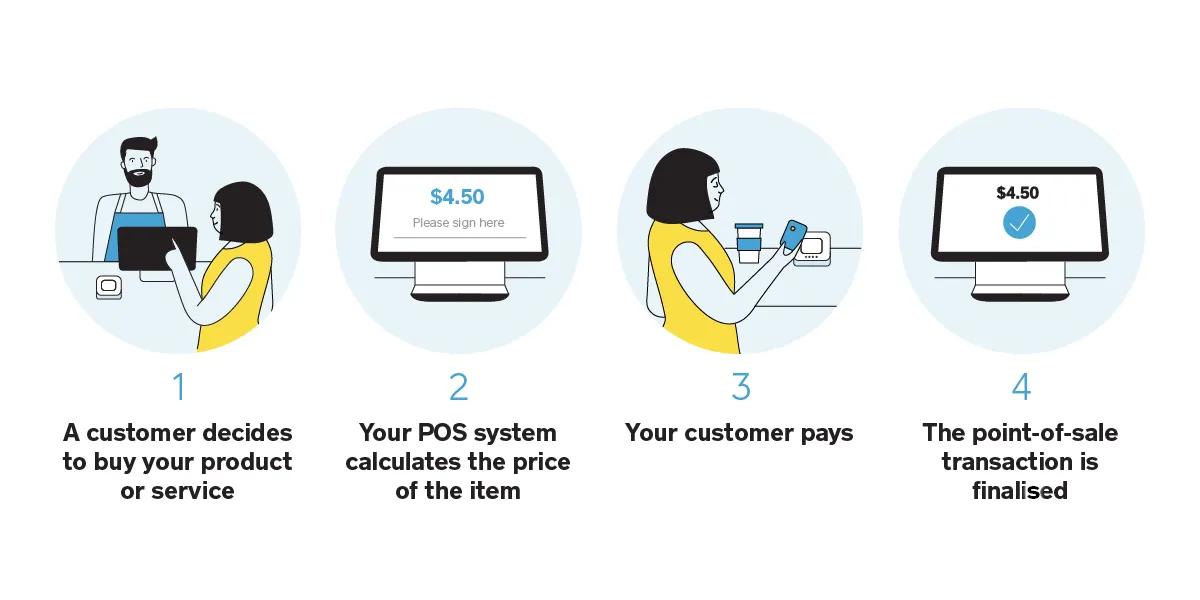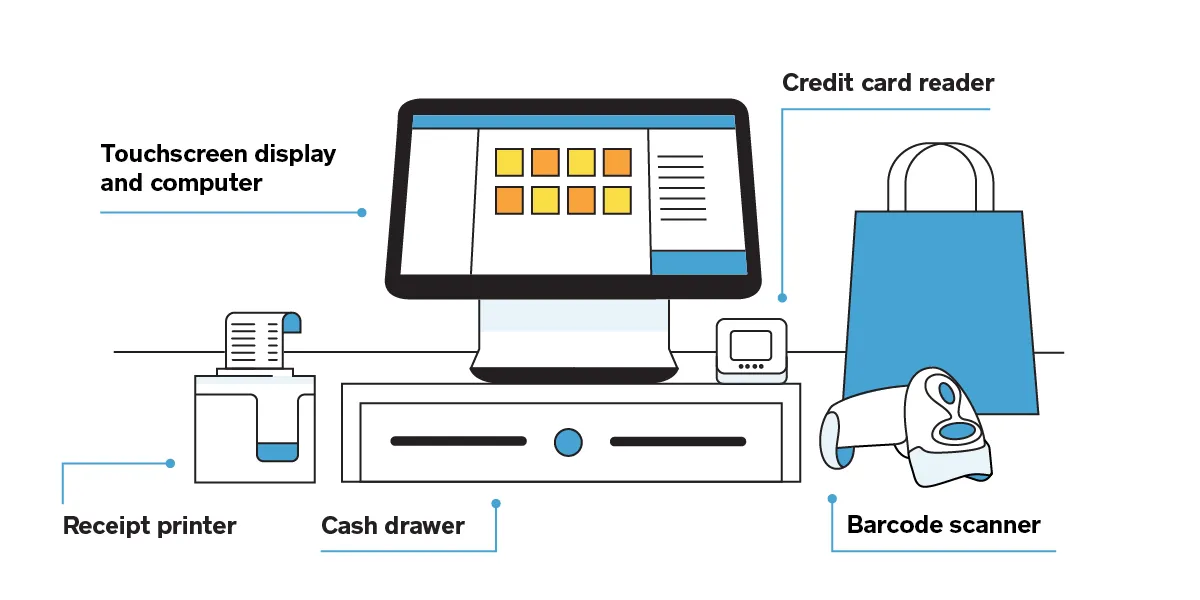Table of contents
A point of sale, or point of purchase, is where you ring up sales for customers. When customers check out online, walk up to your counter, or pick out an item from your stand or booth, they’re at the point of sale.
Your point-of-sale system is the hardware and software that enables your business to make those sales.
How does a POS system work at a small business?
A POS system allows your business to accept payments from customers and keep track of sales. It sounds simple enough, but the setup can work in different ways, depending on whether you sell online, have a physical shop, or both.
In the past, a point-of-sale system referred to the cash register at a shop’s counter. Today, modern POS systems are entirely digital, which means you can check out a customer wherever you are. All you need is a POS app and an internet-enabled device, like a tablet or phone.
So what does a POS system do? Usually, it works like this:

1. A customer decides to buy your product or service. If you have a physical shop, they may ask a sales assistant to ring them up. That assistant could use a barcode scanner to look up the item’s price. Some POS systems, like Square Point of Sale, also allow you to visually scan items using the camera on your device. For online stores, this step happens when a customer finishes adding items to their cart and clicks the checkout button.
2. Your POS system calculates the price of the item, including any GST, and then updates the inventory count to show that the item is sold.
3. Your customer pays. To finish their purchase, your customer will have to use their debit or credit card, mobile, loyalty points, gift card, or cash to make the payment go through. Depending on the type of payment they choose, your customer’s bank then has to authorise the transaction.
4. The point-of-sale transaction is finalised. This is the moment when you officially make a sale. The payment goes through, a digital or printed receipt is created and you ship or hand your customer the items they bought.
What types of hardware and software does a POS system typically include?
Every POS system uses POS software, but not all businesses need POS hardware.
If you have an online store, then all of your sales happen on your website, so you don’t need POS hardware to help you accept payments. But if you have a cafe, you may need a register and a credit card reader. If you operate a food truck, a phone or tablet could be all you need to process orders.
Here’s a rundown of common types of POS hardware and software. Keep in mind that what you need depends on your business.
Common elements of a POS system

Touchscreen display and computer – the central piece you might refer to as a register. It allows you to calculate and process customer transactions and comes in three main forms:
- Computer-based display with a computer case that might sit beneath the counter or attached to the display.
- Mobile-based display hardware such as an iPad with a POS app installed and a case or stand to hold the iPad (such as Square Stand).
- Purpose-built hardware with an integrated computer and display.
Credit card reader: A card reader lets your customers securely pay by debit or credit card while in store.
Cash drawer: Even if you accept contactless payments, you may still need a safe spot to keep your cash. POS software that’s connected to a cash drawer can minimise fraud by tracking exactly when the drawer is opened.
Receipt printer: A paper receipt shows customers exactly when and what they purchased and how much they paid.
Barcode scanner: A barcode scanner reads an item’s product details so you can ring it up. It can also be a quick way to check the price, stock level, and other details.
Common POS software features
Some POS solutions, like Square, include the features below. Other systems may require you to use outside software to get the features you need.
Payment processing
Payment processing is one of the core functions of a POS system. Each time a customer buys an item, your POS system processes the transaction.
There are a number of different payment types a POS system might accept:
- Cash
- Secure online payments through your eCommerce site
- Credit and debit cards with an embedded chip
- Contactless payments, which might include a contactless card that customers tap or a mobile wallet (e.g., Google Pay or Apple Pay)
- Card-not-present transactions, which happens when your customer and their card aren’t actually in front of you, so you have to manually enter their card details. This also happens when customers enter their payment details while checking out online.
Inventory management
Inventory management software lets you keep tabs on all your products. Some automated inventory software can connect with your sales data and let you know when an item is running low.
POS reports
POS reports give you a quick look into how much you’re selling and earning. With clear reports, you can sell more and make better business decisions.
Employee management
[Team management software](https://squareup.com/au/en/point-of-sale/team-management”Team Management “) lets you know when your employees are working and how they’re performing. Your team can also use it to clock in and out, and some types of software can grant permissions so employees can get access to certain tasks.
Customer relationship management (CRM)
A CRM tool that’s tied to POS software lets you see what your customers bought and when they bought it. This knowledge helps you personalise your communications, marketing and customer service.
Receipts
Receipts make processing refunds easier, since there’s a digital or paper trail connected to the purchased item. They can also make your business look more polished.
Tipping support
For restaurants and service professionals, tips can add a nice boost to the daily takings. POS solutions that allow customers to add a digital tip during the checkout process make it more likely that they’ll tip.
Now that you have a better understanding of POS systems, you’re ready to find the right one for your business, no matter what or where you sell.
![]()











